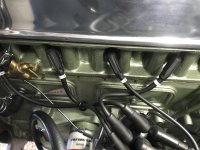AUSMHLY
Yoda
Offline
Hello,
I had the engine rebuilt about 10 months ago. I've put about 200 miles on it as I'm in the process of removing/installing the transmission trying to rebuild it. There is a copper-colored sealant oozing between the head and the block (photo attached). I keep wiping it off, but it keeps oozing.
It's my understanding that the cylinder head nuts need to be re-torqued after X miles on a rebuilt engine. Today I tried to loosen the cylinder head nuts and had to put a steel pipe on the socket ratchet handle to get enough leverage. I loosened them in the order outlined in the workshop manual. To confirm they were loose I used my fingers. To my surprise, all the studs became loose too. Some of the studs came up having the nut frozen on top. I have stud, steel washer, nut (no locking washer which Moss diagram shows).
The Workshop Manual says, "Ensure that a bronze washer is fitted below the steel washer on each stud which passes through the inlet manifold on the left-hand side of the head, " but I don't see a diagram in the Workshop Manual that shows that. The Moss diagram shows (16) bronze washers for the 100-6 (2-port) engine. Moss diagram for the 3000 (6-port) shows stud, plain washer, locking washer, nut.
1) Should the 3000 have 16 bronze washers?
2) How do I reinstall the studs? Moss states, "All cylinder head studs should be put in the block only finger tight to avoid cracking the block."
I certainly don't want to crack the block. So, finger tight (with or without blue Loctite?), then how do I install the studs to get 33 lbs?
3) Once studs are in, (bronze washer?) steel washer, (locking washer?) nut torqued to 75 lbs. (I currently have steel washer/nut.)
Concerns: When I torque the nuts to 75, will it also re-torque the studs more then 33 lbs and possibly crack the block?
I thought this would be a simple exercise of loosen nuts, then torque to 75 lbs.
I had the engine rebuilt about 10 months ago. I've put about 200 miles on it as I'm in the process of removing/installing the transmission trying to rebuild it. There is a copper-colored sealant oozing between the head and the block (photo attached). I keep wiping it off, but it keeps oozing.
It's my understanding that the cylinder head nuts need to be re-torqued after X miles on a rebuilt engine. Today I tried to loosen the cylinder head nuts and had to put a steel pipe on the socket ratchet handle to get enough leverage. I loosened them in the order outlined in the workshop manual. To confirm they were loose I used my fingers. To my surprise, all the studs became loose too. Some of the studs came up having the nut frozen on top. I have stud, steel washer, nut (no locking washer which Moss diagram shows).
The Workshop Manual says, "Ensure that a bronze washer is fitted below the steel washer on each stud which passes through the inlet manifold on the left-hand side of the head, " but I don't see a diagram in the Workshop Manual that shows that. The Moss diagram shows (16) bronze washers for the 100-6 (2-port) engine. Moss diagram for the 3000 (6-port) shows stud, plain washer, locking washer, nut.
1) Should the 3000 have 16 bronze washers?
2) How do I reinstall the studs? Moss states, "All cylinder head studs should be put in the block only finger tight to avoid cracking the block."
I certainly don't want to crack the block. So, finger tight (with or without blue Loctite?), then how do I install the studs to get 33 lbs?
3) Once studs are in, (bronze washer?) steel washer, (locking washer?) nut torqued to 75 lbs. (I currently have steel washer/nut.)
Concerns: When I torque the nuts to 75, will it also re-torque the studs more then 33 lbs and possibly crack the block?
I thought this would be a simple exercise of loosen nuts, then torque to 75 lbs.
Attachments
Last edited:

 Hi Guest!
Hi Guest!

 smilie in place of the real @
smilie in place of the real @
 Pretty Please - add it to our Events forum(s) and add to the calendar! >>
Pretty Please - add it to our Events forum(s) and add to the calendar! >> 


